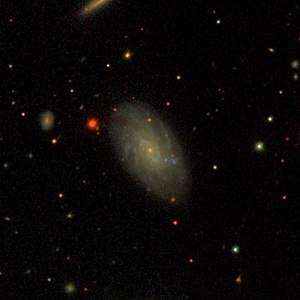NGC 496
NGC 496, also occasionally referred to as PGC 5037, UGC 927 or GC 288, is a spiral galaxy in the constellation Pisces.[2] It located approximately 250 million light-years from the Solar System[4] and was discovered on 12 September, 1784 by astronomer William Herschel.[5]
| NGC 496 | |
|---|---|
 SDSS view of NGC 496 | |
| Observation data (J2000[1] epoch) | |
| Constellation | Pisces[2] |
| Right ascension | 01h 23m 11.6s[3] |
| Declination | +33° 31′ 45″[3] |
| Redshift | +0.020258 ± 0.000093[1] |
| Helio radial velocity | (6011.7 ± 27.8) km/s[1] |
| Distance | 250 Mly[4] |
| Apparent magnitude (V) | 13.4[2] |
| Characteristics | |
| Type | Sbc[2] |
| Apparent size (V) | 1.6' × 0.9'[2] |
| Other designations | |
| PGC 5061, UGC 927, GC 288, MCG 5-4-36, 2MASS J01231161+3331452, H 3.157, IRAS 01203+3316, CGCG 502-60, KUG 0120+332A[2][1][5] | |
Observation history
The object was discovered by Herschel along with NGC 495 and NGC 499. He initially described the discovery as "Three [NGC 496 along with NGC 495 and 499], eS and F, forming a triangle.". As he observed the trio again the next night, he was able to make out more detail: "Three, forming a [right triangle]; the [right angle] to the south NGC 499, the short leg preceding [NGC 496], the long towards the north [NGC 495]. Those in the legs [NGC 496 and 495] the faintest imaginable; that at the rectangle [NGC 499] a deal larger and brighter, but still very faint."[6]
NGC 496 was later also observed by Bindon Blood Stoney[5]. This position is also noted in the New General Catalogue.[6]
See also
- Spiral Galaxy
- List of NGC objects (1–1000)
- Pisces (constellation)
References
- "NGC 496". Retrieved 2017-11-07.
- "Revised NGC Data for NGC 496". spider.seds.org. Retrieved 2017-10-05.
- "Your NED Search Results". ned.ipac.caltech.edu. Retrieved 2017-11-07.
- An object's distance from Earth can be determined using Hubble's law: v=Ho is Hubble's constant (70±5 (km/s)/Mpc). The relative uncertainty Δd/d divided by the distance is equal to the sum of the relative uncertainties of the velocity and v=Ho
- "New General Catalog Objects: NGC 450 - 499". cseligman.com. Retrieved 2017-11-07.
- "astronomy-mall.com/Adventures.In.Deep.Space/NGC%201-7840%20complete.htm". Astronomy Mall. Retrieved 2017-11-07.
External links
| Wikimedia Commons has media related to NGC 496. |
- NGC 496 on WikiSky: DSS2, SDSS, GALEX, IRAS, Hydrogen α, X-Ray, Astrophoto, Sky Map, Articles and images
- SEDS